
Berks County is a county located in the U.S. commonwealth of Pennsylvania. As of the 2020 census, the population was 428,849. The county seat is Reading.

Marion Township is a township in Berks County, Pennsylvania, United States. The population was 1,688 at the 2010 census.

Shoemakersville is a borough in Berks County, Pennsylvania, United States. The population was 1,378 at the 2010 census, down from 2,124 at the 2000 census.
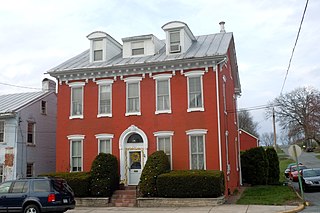
Womelsdorf is a borough in Berks County, Pennsylvania, United States. The population was 2,810 at the 2010 census. The main thoroughfares through Womelsdorf are High Street, which runs east–west, and Pennsylvania Route 419, which runs north–south. U.S. Route 422 runs along the northern edge of town.
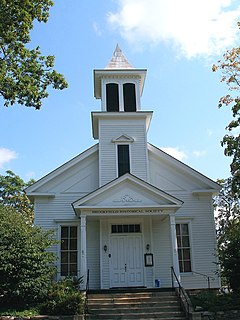
The Brookfield Center Historic District in Brookfield, Connecticut is a historic district that was listed on the National Register of Historic Places in 1991. It is located in the vicinity of the junction of Route 133 and Route 25. The district represents the original settlement of the town of Brookfield and contains 67 residential, religious, and municipal buildings over a 43-acre (17 ha) area representing a wide range of architectural styles from the 18th to 20th centuries including Bungalow/Craftsman, Greek Revival, and Queen Anne style architecture. The district includes the old town hall, the Congregational Church of Brookfield, Saint Joseph Church & Elementary School, Center Elementary School (Public), the former general store, St. Paul's Episcopal Church, and the surrounding residential neighborhood. The district is architecturally significant as an accurate representation of the historical development of the original settlement of the Town of Brookfield as the buildings are well-preserved from the time they were built with minimal alterations and intrusions, including their spatial relationships to one another.

Virginville is a census-designated place in Richmond Township, Berks County, Pennsylvania. It is located at the junction of PA 143 and Crystal Ridge Road, and is approximately 7 miles to the south of the borough of Lenhartsville.

The West Saint Clair Street Historic District is a residential historic district located along 124–328 West Saint Clair Street in the village of Almont in Almont Township in southeast Lapeer County, Michigan. It was designated as a Michigan State Historic Site and also added to the National Register of Historic Places on May 8, 1986.

High Street Historic District is a national historic district located in Pottstown, Montgomery County, Pennsylvania. It encompasses 124 contributing buildings and 1 contributing structure in an upper- and middle-level residential section of Pottstown. The district includes late-19th and early-20th century mansions and stylish homes built between 1860 and 1941. They are in a variety of popular architectural styles including Queen Anne, American Foursquare, Victorian Gothic, Late Federal and Italianate. Notable non-residential buildings include a gas station, St. John's Reformed Church (1916), St. James Evangelical Lutheran Church, and Pottstown Memorial Hospital. It includes the separately listed Grubb Mansion.
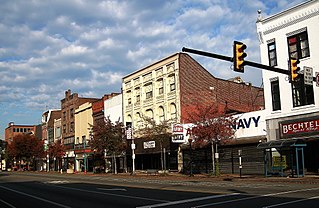
Old Pottstown Historic District is a national historic district located in Pottstown, Montgomery County, Pennsylvania. It encompasses 956 contributing buildings and 1 contributing site in the central business district and surrounding residential areas of Pottstown. The district includes a variety of residential buildings including workers' home and residences of prominent and wealthy citizens in a variety of architectural styles including Late Victorian, Gothic Revival, and Federal. This includes the separately listed Pottsgrove Mansion. Notable non-residential buildings include the Italianate style commercial buildings on High Street, 1725 Roller Mills, Reading Railroad station (1928), Doehler-Jarvis castings plant, Light Foundry building (1880), Ecker Building, Weitzenkorn Building, Security Trust Building (1888), Elks Home (1896), Pottstown Library (1920), Pottstown Borough Hall (1924), Masonic Temple (1926), Christ Episcopal Church (1872), First Methodist Church (1869), and St. Aloysius Roman Catholic Church (1891). Also in the district is the Searles Memorial Methodist Church (1911) designed by architect Joseph Miller Huston (1866–1940).
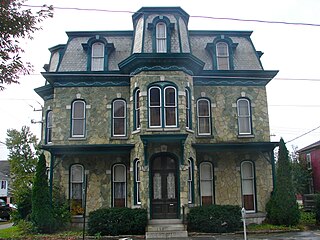
Danville Historic District is a national historic district located in Danville, Montour County, Pennsylvania. It encompasses 291 contributing buildings, 3 contributing sites, and 1 contributing object in the central business district and surrounding residential areas of Danville. The buildings mostly date from the 1840s to the early 20th century. The district incorporates the previously listed and predominantly residential Danville West Market Street Historic District. Residential buildings are mostly of brick and frame construction, with some log and stone dwellings, and in a variety of architectural styles including Italianate, Federal, Queen Anne and Second Empire. It includes the separately listed General William Montgomery House and Thomas Beaver Free Library and Danville YMCA. Other notable non-residential buildings include the Montour County Courthouse (1871), Mahoning Presbyterian Church (1853), Pine Street Lutheran Church, Eli Trego Building, Heim Suspender Factory (1835), First Ward School, Bnai Zion Temple, and Jemima Donaldson's Cross Keys Tavern.
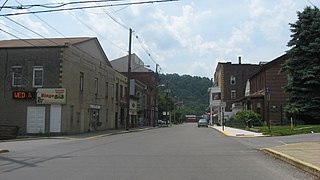
Emlenton Historic District is a national historic district located at Emlenton, Venango County, Pennsylvania. The district includes 317 contributing buildings, 57 contributing structures, and 1 contributing object in the central business district and surrounding residential areas of Emlenton. It includes commercial, residential, industrial, and institutional buildings. They are in a variety of popular architectural styles including Italianate, Greek Revival, and Gothic Revival.

Waterford Borough Historic District is a national historic district located at Waterford, Erie County, Pennsylvania. It includes 41 contributing buildings in the central business district and surrounding residential areas of Waterford. The district includes commercial and residential buildings built between 1820 and 1939. They are in a variety of popular architectural styles including Greek Revival, Federal, and Italianate. The district includes the town square. Notable buildings include the St. Peter's Episcopal Church (1832), Presbyterian Church, Amos Judson House, and Judson's Store (1820). The district includes the separately listed Eagle Hotel (1826).

The John Nicholas and Elizabeth Moyer House, also known as "Richland," is a historic home located in Jefferson Township, Berks County, Pennsylvania. Built circa 1817, it is a 2+1⁄2-story, four-over-four stone dwelling. A stone summer kitchen, which was built between 1818 and 1820, is attached to the rear. Frame additions were added in 1998.

Kemp's Hotel is a historic inn and tavern building located at Maxatawny Township, Berks County, Pennsylvania. It was built about 1740, and is a 2 1/2-story, rectangular limestone building. A two-story, four bay, western addition and one-story rear wing was built in 1852. The building has a slate covered gable roof.

The Hamburg Historic District is a national historic district located in Hamburg, Berks County, Pennsylvania. The district encompasses 435 contributing buildings in the borough of Hamburg, and is bordered, roughly, by Franklin, Windsor, Walnut, and Second Streets; Quince, Primrose, Peach, and Plum Alleys; and Mill Creek.

Morgantown Historic District, also known as Old Main Street Historic District, is a national historic district located in Caernarvon Township, Berks County, Pennsylvania. The district encompasses 104 contributing buildings, 1 contributing structure, and 1 contributing object in the village of Morgantown built between about 1790 and 1945. It includes residential, commercial, and institutional buildings in a variety of popular architectural styles including Georgian and Late Victorian. The oldest buildings are mostly built of brown sandstone. A primarily residential district, notable non-residential buildings include a tavern / hotel, I.O.O.F. lodge / town meeting hall (1868), Morgantown Garage (1920), and fire hall (1921). Also in the district are a contributing cemetery and war memorial.

Oxford Historic District is a national historic district located in Oxford, Chester County, Pennsylvania. It encompasses 517 contributing buildings, 1 contributing sites, and 1 contributing structure in the central business district and surrounding residential areas of Oxford. They are mostly brick residential and commercial structures built between 1870 and 1910 and in a variety of popular architectural styles including Queen Anne and Italianate. Notable non-residential buildings include the Oxford Hall, Octoraro Hotel, Oxford Station, Dickey Building, Masonic Building, Fulton Bank Building (1925), Gibson's Store, Orthodox Friends Meeting House, Methodist Church (1885), United Presbyterian Church (1893), and the Oxford Grain & Hay Company granary (1880). The Oxford Hotel is located in the district and listed separately.
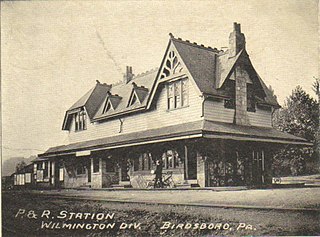
The Reading Company used two passenger railway stations in or near Birdsboro, Pennsylvania. The Philadelphia and Reading Railroad built a station on its Main Line in Exeter Township, on the opposite side of the Schuylkill River from Birdsboro. The Wilmington and Northern Railroad established a freight line to Birdsboro in 1870, but it was not until after its merger with the Reading Company that its passenger station was built in the borough.

The Reading Artillerists was a militia organization founded in Reading, Berks County, Pennsylvania during the late 18th century. Mustering in for the first time during the presidential era of George Washington, members of this artillery unit went on to serve tours of duty in the War of 1812, Mexican–American War and, as members of the Union army of the United States, during the American Civil War, before disbanding. Having determined that Reading needed to improve its military readiness, civic leaders of the 1880s authorized the formation of a new artillery unit, and also chose to name it as "Reading Artillerists" in deference to the original unit's storied history. That militia unit then mustered in for the Spanish–American War, and continued its service during the early part of the 20th century.
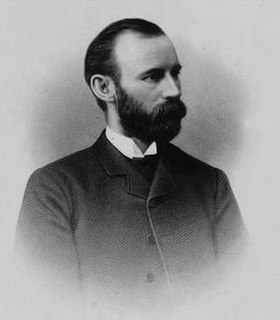
Morton Luther Montgomery (1846–1933) was a native-born Pennsylvanian and Harvard-trained lawyer who became a respected military and public historian and author of more than a dozen books, lecture-related content and other materials documenting the history of the Commonwealth of Pennsylvania from its earliest days through the early part of the 20th century.
























